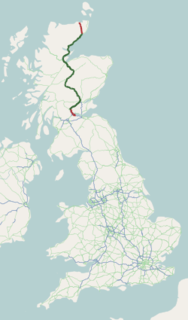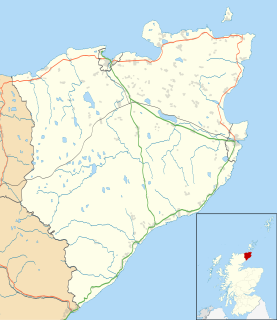
The A9 is a major road running from the Falkirk council area in central Scotland to Scrabster Harbour, Thurso in the far north, via Stirling, Bridge of Allan, Perth and Inverness. At 273 miles (439 km), it is the longest road in Scotland and the fifth-longest A-road in the United Kingdom. Historically it was the main road between Edinburgh and John o' Groats, and has been called the spine of Scotland. It is one of the three major north-south trunk routes linking the Central Belt to the Highlands - the others being the A82 and the A90.

Thurso is a town and former burgh on the north coast of the Highland council area of Scotland. Situated in the historical area of Caithness, it is the northernmost town on the British mainland.

Caithness is a historic county, registration county and lieutenancy area of Scotland.

Helmsdale is a village on the east coast of Sutherland, in the Highland council area of Scotland. The modern village was planned in 1814 to resettle communities that had been removed from the surrounding straths as part of the Highland Clearances.
Thurso Bay, known also as Scrabster Bay, is a bay of Atlantic water between the points of Clairdon Head and Holborn Head on the north coast of Caithness, Scotland.

Caithness, Sutherland and Easter Ross is a constituency of the House of Commons of the Parliament of the United Kingdom (Westminster). It is the most northerly constituency on the British mainland. It elects one Member of Parliament (MP) by the first-past-the-post system of election.

The A836 is a major road entirely within the Highland area of Scotland. It is 122 miles (196 km) long and runs from Ross and Cromarty to Caithness, with the majority of its length in Sutherland. At 58.648°N where it passes through East Mey, it is the northernmost A-class road in mainland Great Britain.

The A882 road is entirely within Caithness in the Highland area of Scotland. It has a length of about 23 kilometres (14 mi) and runs generally west/northwest from the A99 in the county town of Wick to the A9 in the Georgemas area.
Holborn Head is a headland on the north-facing Atlantic coast of Caithness, in the Highland area of Scotland. The point of Holborn Head is at 58°37′23″N03°32′06″W. It has a lighthouse at its south end and the remains of an old fort at its tip.
Thurso High School in Thurso, Caithness, Scotland, is the most northerly secondary school on mainland Great Britain.

Thurso railway station is a railway station located in Thurso, in the Highland council area in the far north of Scotland. It serves the town of Thurso and its surrounding areas in the historic county of Caithness. It is also the nearest station to the port of Scrabster, which has ferry services linking the mainland with Stromness on the Orkney Islands. It is the northernmost station on the National Rail network.

The Wolf Burn is a small stream, running from a suspect subterranean source behind the Ormlie housing estate in Thurso, Highland Region in the United Kingdom. Its issue is by Burnside, Caithness. A ribble of stones represents the Wolfburn distillery which operated for a number of decades around the mid 19th Century.

The Bishop of Caithness was the ecclesiastical head of the Diocese of Caithness, one of Scotland's 13 medieval bishoprics. The first referenced bishop of Caithness was Aindréas, a Gael who appears in sources between 1146 and 1151 as bishop. Aindréas spent much if not all of his career outside his see.

Braal Castle is located by the River Thurso north of the village of Halkirk, in Caithness, northern Scotland. The ruined castle, which dates back to the mid-14th century, was originally known as the Castle of Brathwell.

Scrabster is a small settlement on Thurso Bay in Caithness on the north coast of Scotland. It is some 1+1⁄2 miles (2.4 km) from Thurso, 22+1⁄2 miles (36.2 km) from Wick, 112 miles (180 km) from Inverness and 271.7 miles (437.2 km) from Edinburgh. Scrabster Harbour is an important port for the Scottish fishing industry.

Clett is a name used for many uninhabited Scottish islets and one to the south, though also in the area inhabited by Vikings. They include -

Spittal is a small hamlet in Caithness, Scottish Highlands and is in the Scottish council area of Highland. Spittal lies 9 miles (14 km) south of Thurso, and 1.5 miles (2.4 km) north of Mybster. The main A9 road runs past Spittal.

Wolfburn distillery is a Scotch whisky distillery in Thurso, Caithness, Scotland. After ceasing production in the 1860s it reopened in 2013.

Thurso Castle is a ruined 19th-century castle, located in Thurso, Caithness, in the Scottish Highlands. Situated in Thurso East, off Castletown Road, east of the River Thurso, the site can be seen from across the river. The current castle ruins date to 1872; A large part was demolished in 1952, although there has been a fortress here since the 12th century. Part of the castle is still habitable and remains a home of the Viscounts Thurso.

Scrabster Castle was a castle, near Burnside, about 0.5 miles (0.80 km) north and west of Thurso, and 0.5 miles (0.80 km) south of the village of Scrabster, Highland in Scotland, south of Thurso Bay. It is on an eroding promontory.

















